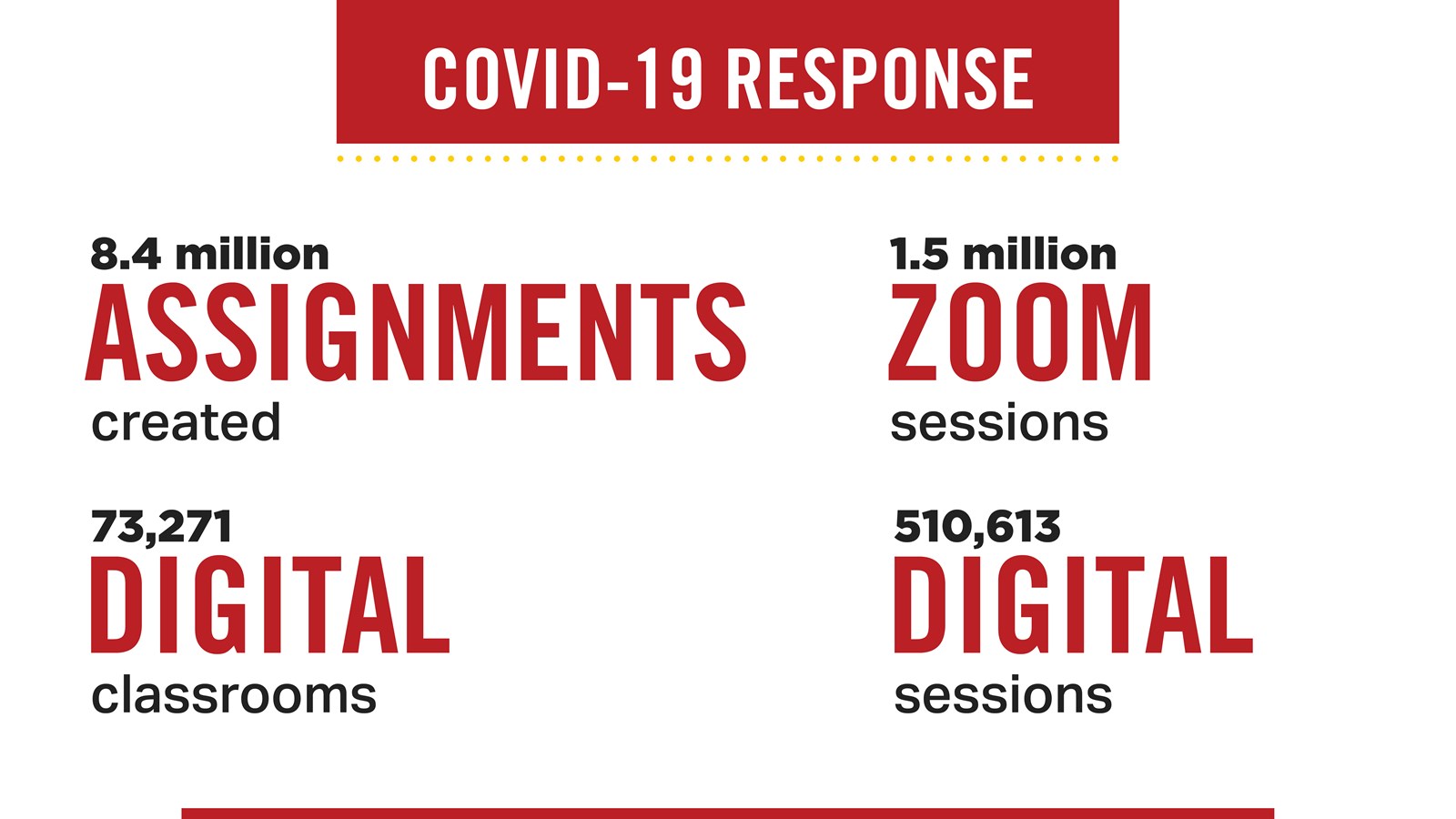Cobb Schools COVID-19 Response Since March
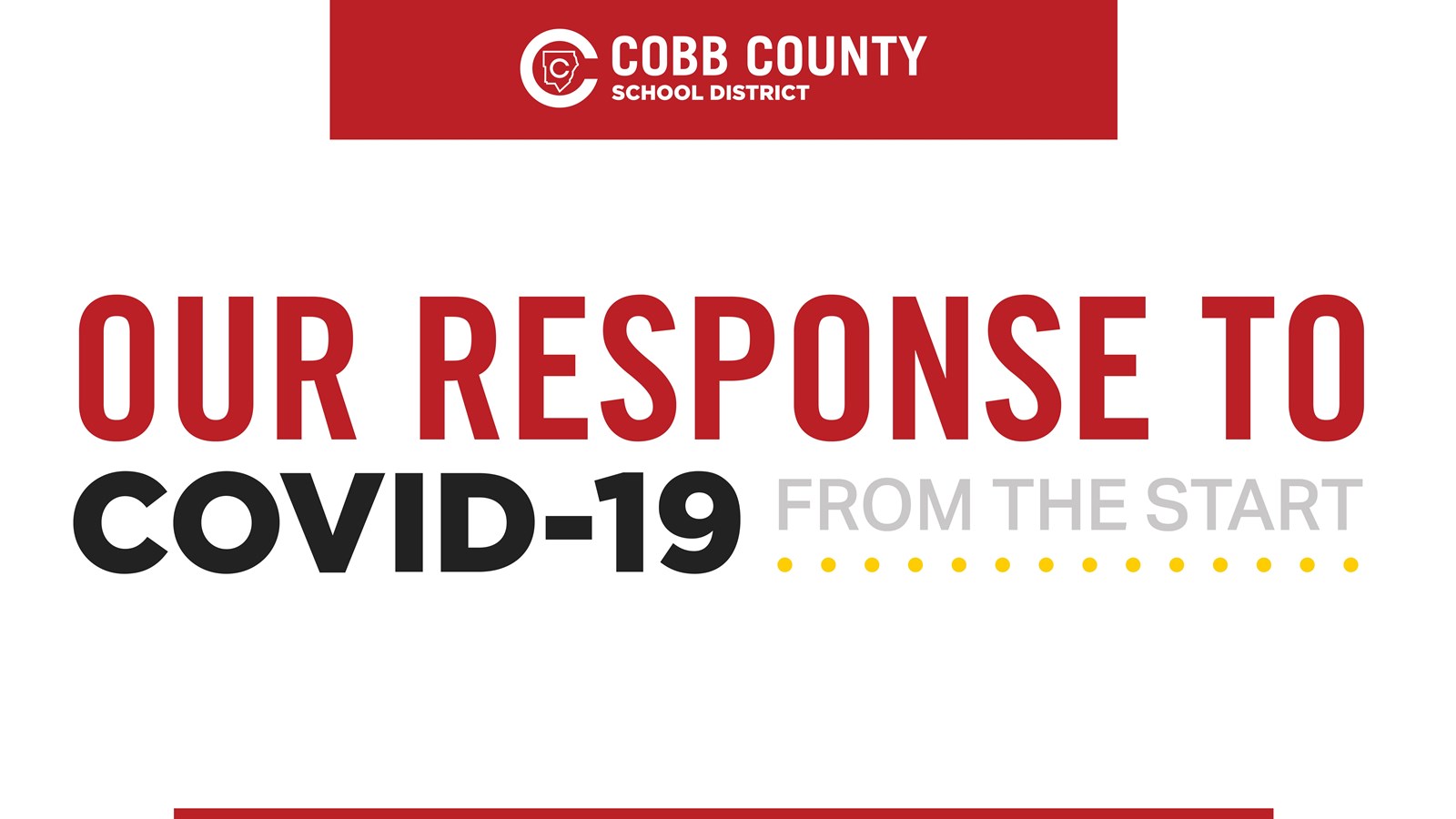
Over the past year, the specific needs of our students, staff, families, and community have changed. However, our commitment to the health, safety, and overall well-being of our school communities has never wavered. The ultimate goal has always been to keep students learning—no matter the obstacles.
From before schools even shut their doors in March, the Cobb Schools response to COVID-19 has focused on five areas:
- What students need
- What staff need
- What families need
- What the community needs
- How we get through this together
Responding with What Students Need
When our school doors closed in March, our students' need for food did not stop. So, the Cobb Schools teamed up with community organizations to open food pantries, hold food drive-bys, and pack meal kits for students across the district. The food was available at no cost. When schools ended for summer break, the food-service continued. In fact, the Cobb Schools Food and Nutrition Services provided students with more than 2.2. million pounds of food from March through July 2020.
For the first semester of the new school year, the Cobb team packed about 1.1 million meal kits for remote students on top of the meals served to face-to-face learners, totaling more than 1.8 million meals. Again, all the food was provided at no cost to students or their families.
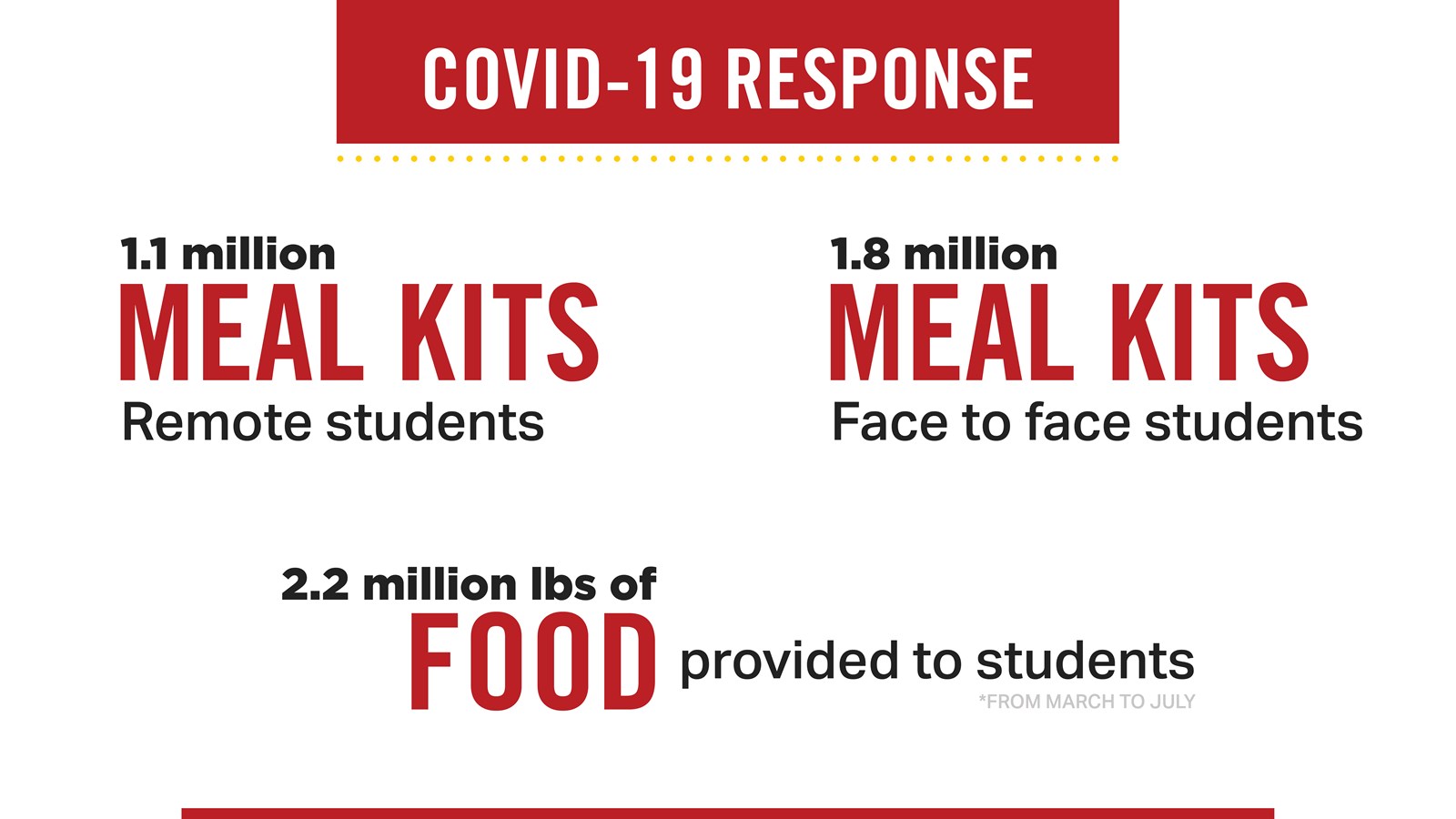
To keep students learning everywhere, a team of Cobb educators spent the first several months of the pandemic working overtime to build an innovative, feature-rich, and easy-to-use digital classroom dubbed CTLS Learn, which is part of the overarching Cobb Teaching and Learning System (CTLS). After CTLS Learn rolled out to students, Cobb's educators did not stop working to improve the digital learning platform. They listened to students, parents, and teachers and updated the CTLS Learn system with their feedback. The updates are not going to stop. Our educators are still listening. After the most recent CTLS Learn update, another one is planned for late spring.
To enable students to learn remotely, the district worked with local community organizations over the past nine months to provide laptops and digital devices to about 45,000 students in need. Additionally, the district deployed 27 school buses equipped with WIFI transmitters to areas around the county deemed to have connectivity issues.
During a time of unprecedented change and uncertainty, students need to be able to look to their school counselors even more for support. Cobb school counselors continued to guide students and developed new ways to support students in a remote environment. For example, to help students cope with the grief process, Cobb Counselors instituted a virtual crisis response plan, which they shared with colleagues across Georgia and beyond. Students also continue to look to counselors to help them navigate the new norms like college applications in the COVID era.
Testing looks different these days. There is an additional social distancing requirement that did not exist in past years. That is why to keep students and staff safe when the PSAT was given in January, the district rearranged the Instructional Support Day, swapping Tuesday for Wednesday. The day change allowed students learning remotely to come into a school building to take the test in a safe environment. Testing locations were expanded beyond high schools to safely accommodate the remote students.
As the conversation around end of course testing was debated around the state, District leadership advocated for students and what was best while students and families faced the unprecedented pandemic.
To maintain a safe and healthy learning environment, fundamental changes were made to the instructional day once students returned to in-person learning. Examples include a phased-in return to learning, wearing masks, limiting class size, physical distancing, eliminating large group gatherings, limiting volunteers and non-essential visitors, providing hand sanitizer, and eliminating activities that involve sharing communal items. A complete list is available under the district's health and safety protocols here.
"Coming back in-person to learn my senior year was important to me, but engaging in safe face-to-face learning was even more important. The teachers and staff have worked hard to make that happen and provide the best opportunity for us," said Harrison High School senior Ethan Perlakowski.
Providing What Staff Need
Many Cobb Schools teachers were already prepared to transition to remote learning back in March, thanks to the Cobb Schools Instructional Technology Team. The educators on the team have long been training teachers on how to transform to digital classrooms.
However, once the entire district switched to remote learning, the Instructional Technology Team jumped in to provide training to teachers on a larger scale. They also made sure teachers were ready to teach remotely via Cobb's one-stop learning platform—CTLS. Before students logged on to CTLS in August, teachers completed extensive training on the new platform. In fact, 1,098 training sessions took place, accounting for more than 42,000 hours of general and specialized instruction. The training has not stopped. The trainers also respond to individual teachers who need help navigating the new technologies, and they provide daily professional learning opportunities.
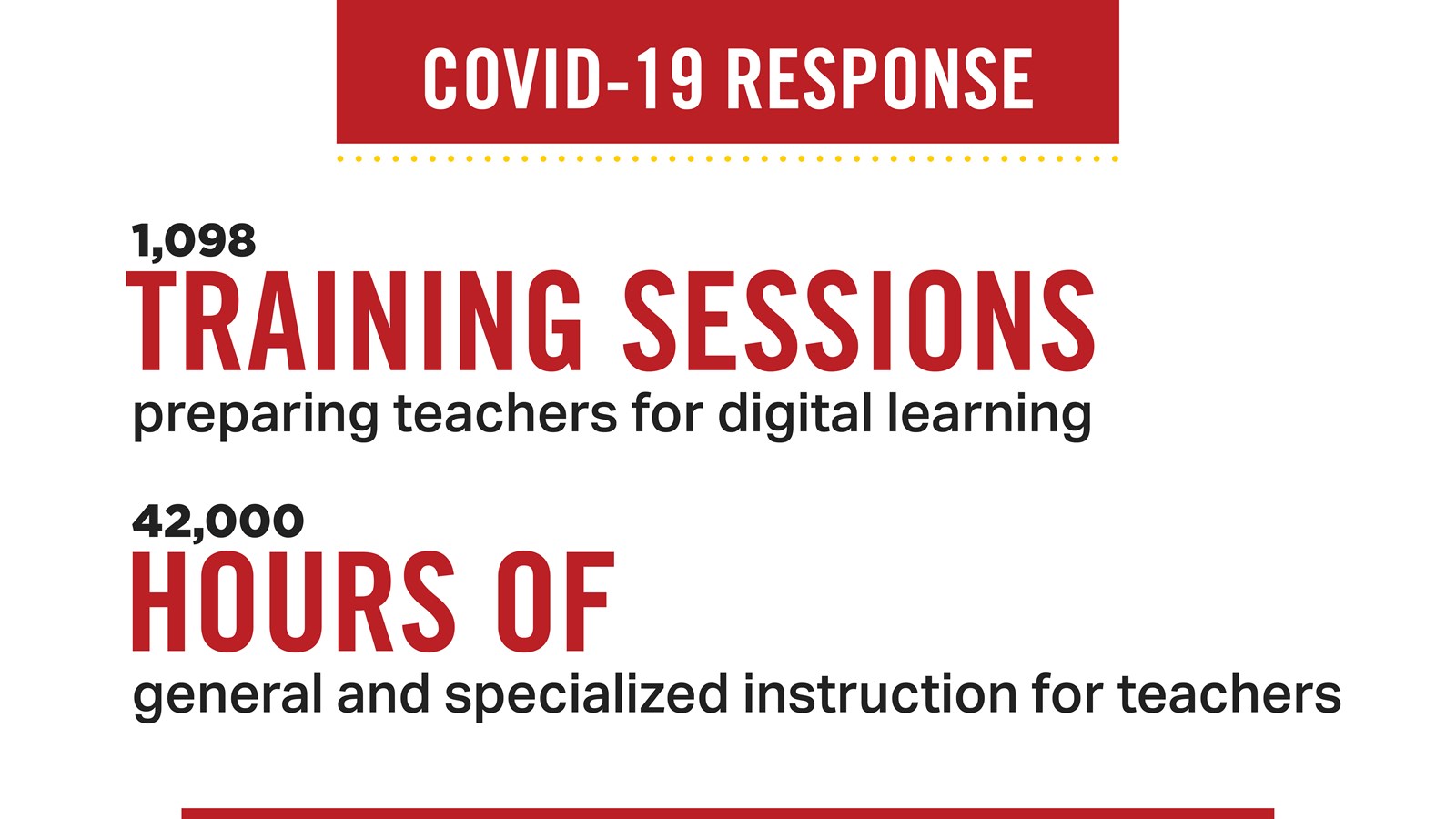
The Cobb educators behind CTLS continue to implement feedback from District staff to make the platform more user friendly and capable of helping teachers teach and students learn. More features are frequently added as the district's response to COVID-19 and remote learning continues.
While the district was working with public health officials to develop our health and safety protocols, all schools went remote in March 2020, with staff members teaching and working from home. Staff continued to get paid during the school closures thanks to a vote by the Cobb Board of Education.
There is no doubt that our school staff deserves a big thank you for all that they have accomplished despite the pandemic impacting the world around them. That is why the district recently supported Georgia Governor Brian Kemp's and State School Superintendent Richard Woods' plan to provide a one-time $1,000 bonus payment to every K-12 public-school teacher and school-level staff member in the state.
"It is honestly a blessing to be a Cobb County teacher. Being a teacher during COVID is no easy task, but I'm so thankful for the understanding that our superintendent has for all our educational needs. I know it's far easier to criticize, but I'm thankful for where I work," said Phil Attard, Osborne High School teacher.
Beyond all the enhanced health and safety protocols and new technologies (detailed more in sections below), District leaders also wanted to take steps to protect staff long term. So, as soon as public health began offering vaccines, Cobb leaders signed up to distribute the vaccine to eligible staff who wanted to be vaccinated. Eligible staff members began receiving the vaccine in early January. Simultaneously, the Cobb leaders took steps to prepare for a wider distribution of vaccines once more staff were eligible. To plan for how many vaccines might be needed, Cobb staff were surveyed on who is interested in receiving a vaccine. District leaders also arranged for representatives from Cobb & Douglas Public Health to hold a virtual town hall with staff to discuss the vaccine and answer any questions staff members may have about it.
Additionally, Superintendent Chris Ragsdale advocated for Cobb staff members by joining other metro-area school superintendents to request that Georgia Governor Brian Kemp add teachers to the Priority Group for Vaccines.
Cobb School leaders will continue to advocate and work to get staff what they need to continue teaching in a safe and healthy environment. After all, Forbes continues to rank Cobb as one of the "Best Place to Work" for a reason.
Offering Families What They Need
Choice—That is what District leaders remain committed to offering families. We understand that COVID-19 has impacted families in many ways. So, giving families the option to choose what type of learning environment is best for their family is an essential part of our COVID-19 response. Just as in past years, District leaders have listened to families.
They even surveyed families to see what their wishes were about returning face-to-face. District leaders understand that families' circumstances change, which is why families have had more than one opportunity to choose the learning environment that best supports their needs.
Most families chose Face-to-Face - with more families choosing this option each time the choice is offered.
"During this pandemic, I have witnessed Cobb children, families, and educators evolve and bond in a way we never thought was possible. Learning how to reach the minds and hearts of my Kindergarten students in this new way of teaching caused me to grow in ways I never thought possible. The kids thought they were growing the most… but it was really me," said Jessica Banta, Davis Elementary kindergarten teacher.
Thanks to CTLS Learn and CTLS Parent, families can be assured that their students will be learning whichever option they choose. One advantage to CTLS for parents is that CTLS Parent increases parents' access to their students' teachers, who are just a quick chat message away.
Cobb parents can submit suggestions for new updates to CTLS by emailing CTLSParent.Support@cobbk12.org. The CTLS team compiles requests and makes updates that improve the platform as a classroom and communication tool.
Like all new technologies, there are sometimes technical issues that arise, especially when more than 100,000 students and thousands of teachers are logged on at the same. Sometimes the problem is not with the digital learning platform but the digital devices being used to access the learning platform, or it could be the WiFi connection or an external platform like Zoom. To help families know how to begin troubleshooting, the district launched the CTLS Status Monitor.
If parents cannot solve an issue they are experiencing with the digital platform, Cobb's CTLS team is available to help. Learn more here.
COVID-19 has not just impacted the way students learn. It has also caused increased financial hardships on many Cobb families. So as part of Cobb's response to COVID is to help families take care of basic needs. Our school social workers have worked with individual family members to ensure they have access to the resources they need. They continued to work over the summer break to help families. At the beginning of the school year, Cobb's team of dedicated school social workers responded to an increased number of families needing financial assistance and access to food due to the loss of employment. They also heard from more families needing help obtaining laptops and hotspots. They responded to increased requests from families for support ranging from afterschool care and car repairs to mental health. Cobb social workers continue to collaborate with MUST Ministries and provide families opportunities to access food at neighborhood food pantries located at schools throughout the district. They have also increased the Blessings in a Backpack program, which offers students a backpack of food to take home every Friday. All that is on top of the work they do to help the Food and Nutrition team put free meal kits in the hands of students in Cobb.
Our Food and Nutrition team has made it easier for families to pick up the free student meal kits from locations across the district with no reservations required. Parents looking to cross one more to-do item off their list can purchase dinner kits on MyPaymentsPlus.com for the whole family.
Creating What the Community Needs
In addition to keeping our students, staff, and families informed through various communication channels, District leadership has also aimed to keep the general Cobb community updated on our response to COVID-19.
The Learning Everywhere page is designed as a one-stop source for all the information related to the Cobb Schools response to the ongoing pandemic.
The page includes:
- Frequently Asked Questions
- Cobb Schools Health and Safety Protocols
- Resources for Learning, Public Health Guidance, and Student Meals
- News Related to COVID and How Students Are Learning
One common question in the community relates to the number of COVID cases. Cobb's leadership team listened and created the COVID Case Notification page. When the community asked for more details beyond active totals, the district added another column to show the cumulative totals. Following the Cobb & Douglas Public Health Department's guidance, the district updates the page every Friday.
To be transparent, we also wanted to provide the community with the data related to how many families have chosen to return to face to face or stay remote. The first-semester choice data was shared here, while the updated data for the second-semester choice was posted here.
When a student or staff member is unfortunately diagnosed with COVID, our team helps our partners at Cobb & Douglas Public Health contact trace. This enables the public health department to better inform those who may be a close contact and need to quarantine—preventing further spread of the virus.
Education is also a crucial part of the Cobb Schools COVID response. We have helped share information from public health to educate staff, students, and families on stopping the spread. We have written articles, created videos, and released podcasts to help educate the public. We have shared the information via email, social media, the District website, CTLS, Board meetings, and public signage posted throughout school buildings.
We will continue our public education campaign, providing the answers the public needs through a variety of communication channels.
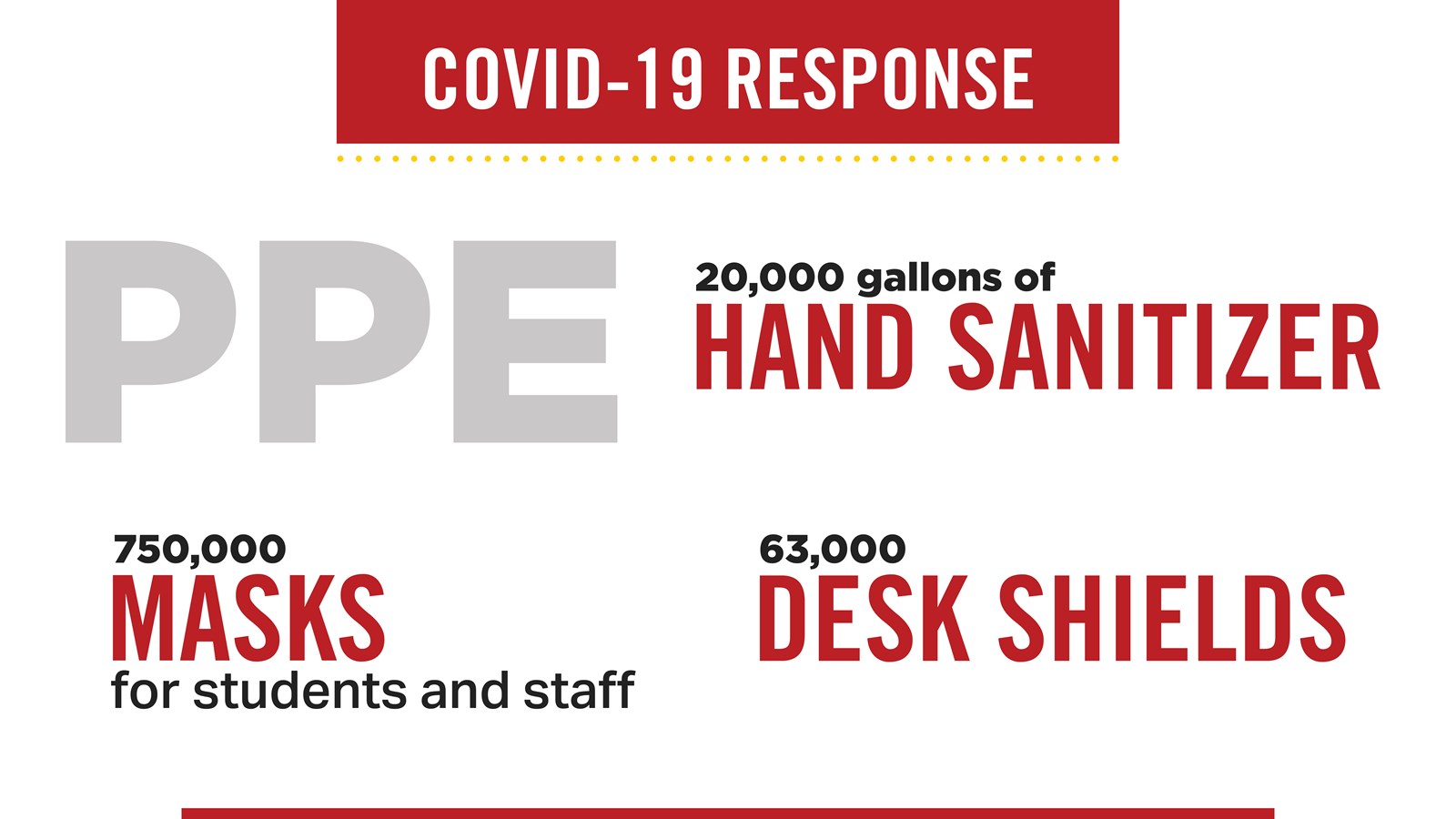
How We Get Through This Together
From the beginning, District leaders have looked to the public health experts for guidance on how to keep students and safe during the pandemic.
Following guidance from public health and Georgia leaders, Cobb Schools transitioned to full remote learning in March 2020 to slow the spread of COVID-19. As soon as school doors closed to in-person learning, our Cobb community showed why this is one of the best places to live. From food to digital devices, our community members immediately jumped in to help our school leaders provide for those in need. Support from community groups and Partners in Education has continued throughout the pandemic. One recent example is the February donation of 30 new chrome books for Milford Elementary School students to keep.
Beyond the community's donations to those in need, District leadership knew that reopening schools in the Fall and maintaining the health and safety of students, staff, and ultimately the community would require the district to take significant steps and make changes to the learning environment: Some of those steps and changes include:
- Require masks for students and staff
- Enhance health and safety protocols
- Institute daily disinfecting procedures
- Invest in adding new sanitizing technology to schools
- Adopt a fogging and disinfecting system that will allow students and staff to safely return immediately after the fogging procedure is complete
- Launch a phased-in return to face-to-face learning
- Continue the 4-day school week to allow for deep cleaning of schools mid-week
- Invest in the further build-out of CTLS, a digital learning platform to support teaching and learning long after the pandemic ends
- Install Personal Protective Equipment (PPE) in schools
- Add new procedures to keep bus drivers and riders safe
- Distribute vaccines to staff who want to get vaccinated
- Close schools when public health guidance advises
- Remain in constant contact with the Cobb & Douglas Public Health
Part of the PPE provided includes more than 750,000 face masks for children and staff plus about 20,000 gallons of hand sanitizer. The PPE supply also includes protective desk shields, foggers, multiple hand sanitizer stations for every building. In fact, to maintain social distancing inside classrooms, the district has more than 63,000 student desk shields. Other PPE items include isolation gowns, thermometers, and transparent administrative shields. Community partners and individual schools may have supplied additional PPE items.
The district did not stop with the standard PPE items. District leaders began testing new technologies that would help make Cobb Schools not only the best place to teach, lead, and learn but also the safest.
When Superintendent Ragsdale spoke about the new sanitizing technologies, he said, "These technologies which could keep students and teachers safe were necessary before and definitely are now. One day, COVID-19 will be in the rearview mirror, but health and safety will remain a priority in our schools and classrooms."
The district's response to COVID has earned praise from people like Representative Bert Reeves who commended Cobb Schools and Superintendent Ragsdale for implementing the new sanitizing technology.
"I am proud of Superintendent Ragsdale and his vision on this [new technology]," Representative Reeves said. "The commitment that Cobb has given to safely reopening is inspiring. Cobb has handled this perhaps the best in the entire state, and I am very proud of all the work that has gone into this."
The Cobb Schools response to COVID-19 and includes more specifics than can be included in one article. Bookmark the District's Learning Everywhere page for an even more expansive and updated list of how we have responded to COVID over the past year.
In addition to the district's steps to keep school campuses safe, we can all help prevent the spread of COVID-19 by self-screening before work or school and following the District well-being checklist. We can also look to information provided by public health and District sources instead of relying on hearsay from social media and unverified sources.
We continue to ask the community to join us in following public health guidance—wear masks and social distance. Together, we can keep our school doors open, our students learning, and our community safe and healthy.

